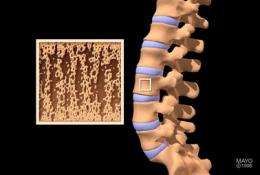Researchers discover new technique for detecting bone loss

Airing for the first time last night on KAET's "ASU Discovers," the work of scientists at ASU including Ariel Anbar, a professor in ASU's Department of Chemistry and Biochemistry and the School of Earth and Space Exploration and NASA's Scott M. Smith, NASA nutritionist was highlighted.
These researchers have taken on the medical challenge of early detection of bone loss by developing and applying a technique that originated in the Earth sciences. In a new study, this technique was more sensitive in detecting bone loss than the X-ray method used today, with less risk to patients. Eventually, it may find use in clinical settings, and could pave the way for additional innovative biosignatures to detect disease.
"Osteoporosis, a disease in which bones grow weaker, threatens more than half of Americans over age 50," explained Anbar who is also from ASU's College of Liberal Arts and Sciences.
"NASA conducts these studies because astronauts in microgravity experience skeletal unloading and suffer bone loss," said Smith. "It's one of the major problems in human spaceflight, and we need to find better ways to monitor and counteract it. But the methods used to detect the effects of skeletal unloading in astronauts are also relevant to general medicine."
With the new technique, bone loss is detected by carefully analyzing the isotopes of the chemical element calcium that are naturally present in urine. Isotopes are atoms of an element that differ in their masses. Patients do not need to ingest any artificial tracers and are not exposed to any radiation, so there is virtually no risk.
Bone formation favors lighter calcium isotopes and picks them over the heavier ones. Other factors, especially bone destruction, also come into play, making the human body quite complicated.
But 15 years ago, Joseph Skulan, now an adjunct professor at ASU, combined all the factors into a mathematical model that predicted that calcium isotope ratios in blood and urine should be extremely sensitive to bone mineral balance.
"Bone is continuously being formed and destroyed," Skulan explained. "In healthy, active humans, these processes are in balance. But if a disease throws the balance off then you ought to see a shift in the calcium isotope ratios."
Rafael Fonseca, chair of the Department of Medicine at the Mayo Clinic in Arizona, and a specialist in the bone-destroying disease multiple myeloma is partnering with the ASU team on further bone loss research.
"Right now, pain is usually the first indication that cancer is affecting bones. If we could detect it earlier by an analysis of urine or blood in high-risk patients, it could significantly improve their care," Fonseca said.
More information: www.azpbs.org/asu/asu_discovers/















